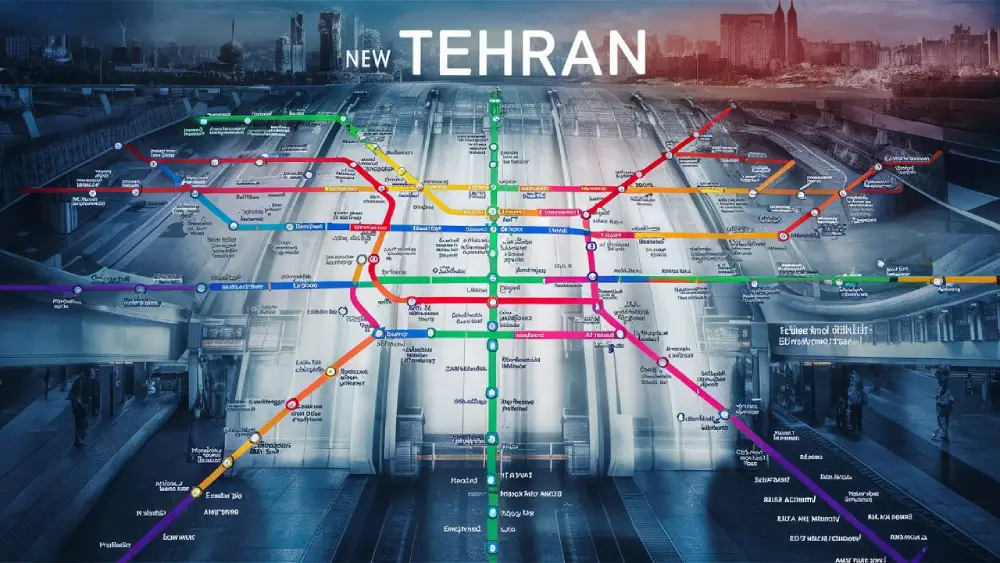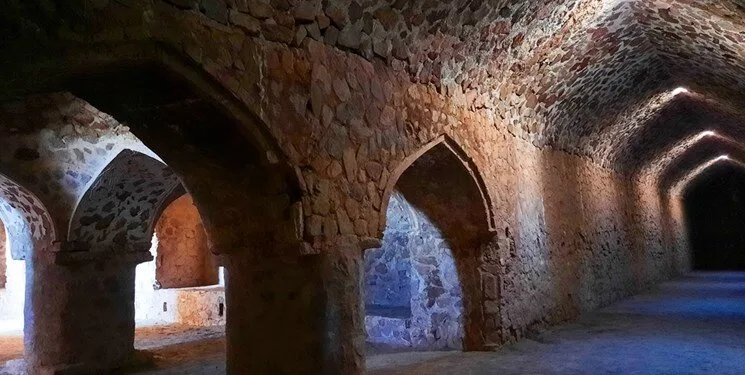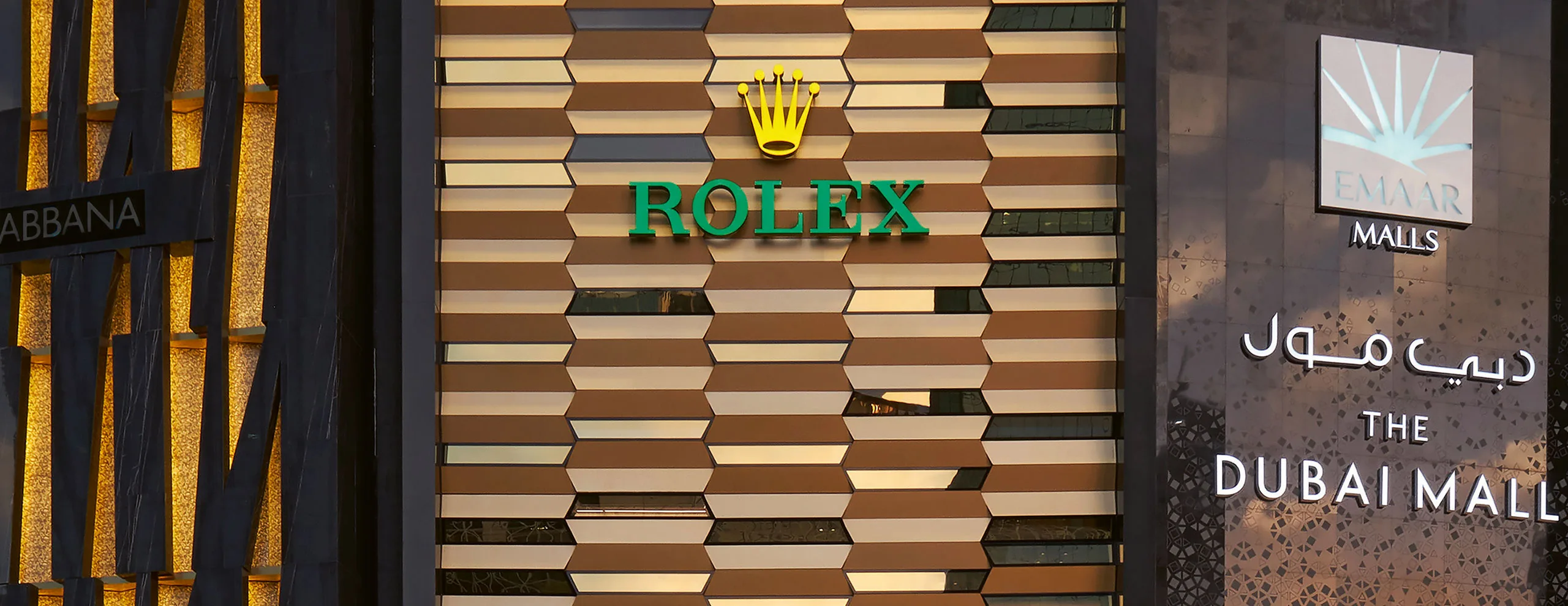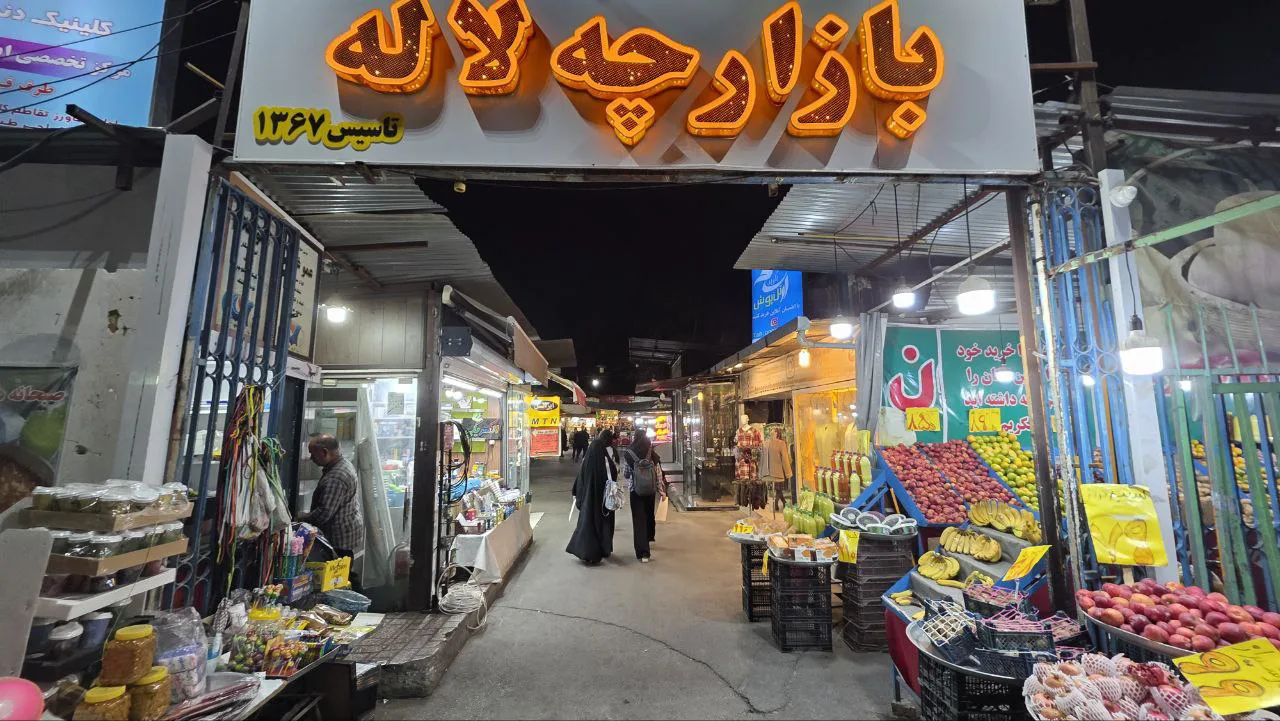New Tehran Metro map
Almost everyone who has lived or commuted in Tehran for a while complains about the heavy traffic. This is despite the fact that Tehran’s metro, with its seven lines and three branches, is operational and transports a significant portion of citizens away from road traffic. In this guide, we will become familiar with the working hours of Tehran’s metro, its lines, and the Tehran metro map.
Let’s take a look at the 2024 Tehran Metro Map
Even if you use the metro a few times a week, having the 2024 Tehran metro map with you could be useful. Of course, all the trains have a Tehran metro map installed, but there are two reasons why these maps might not be helpful:
In some trains, the new Tehran metro map may not have been added yet.
You might want to access the metro map outside the metro. To ensure the map’s accuracy, check the update date next to or below the map.
For this reason, we have provided a high-quality version of the 2024 Tehran metro map for you. Save the new Tehran metro map on your phone to have peace of mind.
The Tehran Metro Map on Google Maps in 2024
As mentioned, we will review the Tehran metro map in the following sections. But before that, we want to look at the Tehran map with the metro system. Do you know why? Because if you view the entire Tehran map with the metro stations in detail, you can get an overall picture of the metro coverage in Tehran.
This will help you understand in which areas of Tehran the metro lines are active and you can use them for commuting.
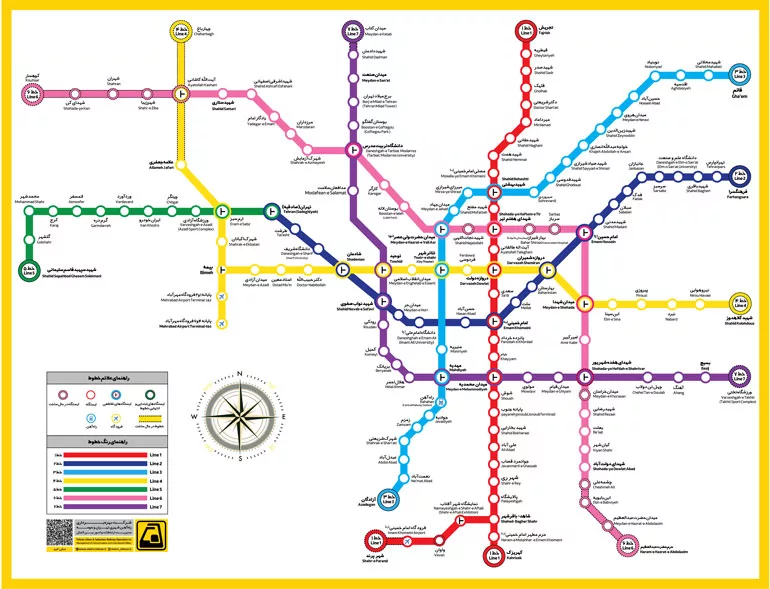
The 2021 Tehran Metro Map
As you can see on the Tehran metro map, the density of metro lines is higher in the central part of the city, but other areas are also somewhat covered. However, you may still need to use buses and taxis in some routes.
Now, let’s get to know the Tehran metro lines
If we ignore the exceptions, the way most people use Tehran’s metro in 2024 follows a relatively fixed pattern; that is, they usually use the Tehran metro for commuting to work and travel on specific lines with set starting and ending points.
If you are one of these citizens, then knowing all the lines on the Tehran metro map might not be very useful. Instead, you can focus on getting to know the line you use most.
In this section of the guide to using Tehran’s metro, we will examine all the active metro lines in Tehran.
Line 1 of Tehran Metro 2024: Tajrish – Khurazk
On the 2024 Tehran metro map, Line 1, which is probably the longest urban metro line, is shown in red. Line 1 connects the northern part of Tehran with the southern part through 29 stations. Here are the stations on Line 1 and its operating hours:
Tajrish
Qeytarieh
Shahid Sadr
Qolhak
Dr. Shariati
Mirdamad
Shahid Haghani
Shahid Hemmat
Mosalla-e Imam Khomeini
Shahid Beheshti
Shahid Mofatteh
Shaheed-e Haft-e Tir
Taleghani
Darvazeh Dowlat
Saadi
Imam Khomeini
Panj-dah Khordad
Khayyam
Meydan-e Mohammadieh
Shush
South Terminal
Shahid Bokharaei
Aliabad
Javanmard-e Qassab
Shahr-e Rey
Palaishgah
Shahid – Bagher Shahr
Imam Khomeini Shrine
Khurazk
According to the 2024 Tehran metro map, it takes about 71 minutes to travel the 37.5 kilometers from the first to the last station on Line 1.
Operating hours for Line 1 are from 5:30 AM to 10:30 PM. However, due to the national COVID-19 regulations, all metro lines in Tehran and its suburbs operate until 10:00 PM starting from December 1, 2020, until further notice.
Line 2 and the 2024 Tehran Metro Map: Sadeghieh – Farhangsara
Line 2 of the Tehran metro, which might be the most heavily used line, is shown in dark blue on the 2024 map. Line 2 extends from east to west with 22 stations. Here are the stations on Line 2 and its operating hours:
Tehran (Sadeghieh)
Tarasht
Sharif University
Shadman
Shahid Navab Safavi
Meydan-e Har
Imam Ali University
Hassanabad
Imam Khomeini
Mellat
Baharestan
Darvazeh Shemiran
Imam Hussein
Shahid Modarresi
Sabalan
Fadak
Janbazan
Sarsabz
University of Science and Technology
Shahid Bagheri
Tehranpars
Farhangsara
Traveling from the start to the end of Line 2 on the Tehran metro map, which is about 25 kilometers, takes 45 minutes. Operating hours for Line 2 are from 5:30 AM to 10:30 PM. However, due to the national COVID-19 regulations, all metro lines in Tehran and its suburbs operate until 10:00 PM starting from December 1, 2020, until further notice.
Line 3 of Tehran Metro 2024: Qaem – Azadegan
Line 3, shown in light blue on the 2024 Tehran metro map, covers the route from north to south Tehran and vice versa with 25 stations. Here are the stations on Line 3:
Qaem
Shahid Mohallati
Eqdeyeh
Nobonyad
Hosseinabad
Meydan-e Heravi
Shahid Zeynaldin
Khwaja Abdullah Ansari
Shahid Sayad Shirazi
Shahid Ghodosi
Sohrevardi
Shahid Beheshti
Mirza Shirazi
Meydan-e Jehad
Meydan-e Vali Asr
Theatre Shahr
Monirieh
Mahdieh
Rah Ahan
Javadiyeh
Zamzam
Shahrak-e Shariati
Abdolabad
Ne’matabad
Azadegan
Traveling the entire length of Line 3 on the Tehran metro map, which is approximately 33.7 kilometers, takes 60 minutes. Operating hours for Line 3 are from 5:30 AM to 10:30 PM. However, due to the national COVID-19 regulations, all metro lines in Tehran and its suburbs operate until 10:00 PM starting from December 1, 2020, until further notice.
Line 4 of the 2024 Tehran Metro Map: Shahid Kolahdooz – Eram Sabz (Allameh Jafari)
Line 4 of the Tehran metro, shown in yellow, is also one of the busy lines. Note that this line also has a branch towards Mehrabad Airport. Let’s look at the 20 stations on Line 4 according to the Tehran metro map:
Shahid Kolahdooz
Air Force
Nabard
Peyrozi
Avicenna
Meydan-e Shahidan
Darvazeh Shemiran
Darvazeh Dowlat
Ferdowsi
Theatre Shahr
Meydan-e Enqelab-e Eslami
Tawhid
Shadman
Dr. Habibollah
Ustad Moein
Meydan-e Azadi
Bimeh
Shahrak-e Ekbatan
Eram Sabz
Allameh Jafari
Traveling from the start to the end of Line 4 on the Tehran metro map, which is 22.5 kilometers, takes 42 minutes. This line operates from 5:30 AM to 10:30 PM. However, due to the national COVID-19 regulations, all metro lines in Tehran and its suburbs operate until 10:00 PM starting from December 1, 2020, until further notice.
Line 5 of Tehran Metro 2024: Golshahr – Sadeghieh
Line 5, shown in green on the Tehran metro map, connects Golshahr to Sadeghieh with 13 stations. The stations on Line 5 are:
Shahid Soleimani
Shahid Fakhrizadeh
Golshahr
Mohammadshahr
Karaj
Atmosfer
Garmdareh
Vardavard
Iran Khodro
Chitgar
Azadi Stadium
Eram Sabz
Tehran (Sadeghieh)
Line 5 is approximately 67.5 kilometers long, taking 57 minutes to traverse. Its operating hours are from 5:00 AM to 10:30 PM. However, according to the national COVID-19 regulations, all metro lines in Tehran and its suburbs operate until 10:00 PM starting from December 1, 2020, until further notice.
Line 6 of Tehran Metro 2024: Dowlatabad – Imam Hussein and Shahid Sattari – Tarbiat Modares University (Line of Martyrs of Dowlatabad to Koohsaar or Shahid Arman Ali Vardi)
Line 6, shown in pink on the Tehran metro map, is one of the newly established lines with two separate sections, West and East. Due to remaining construction work, its operational schedule is somewhat different. Line 6, with 17 stations and a 27-kilometer route, serves from Dowlatabad to Shahid Sattari Highway as an integrated service.
Several stations on this line are under construction, and the entire line is being extended towards West Tehran. The interval between trains on Line 6 is every 15 minutes.
Martyrs of Dowlatabad
Kian Shahr
Basat
Shahid Rezaei
Amir Kabir
Meydan-e Shahidan
Imam Hussein
Martyrs of 7th Tir
Meydan-e Hazrat Vali Asr (AJ)
Laleh Park
Kargar
Tarbiat Modares University
Shahrak-e Azmaish
Marzdaran
Yadgar-e Imam
Shahid Ashrafi Esfahani
Shahid Sattari
Shahr-e Ziba
Shahran
Shahid Arman Ali Vardi (Koohsaar)
According to the national COVID-19 regulations, operating hours for all metro lines in Tehran and its suburbs are from 5:30 AM to 10:00 PM starting from December 1, 2020, until further notice.
Line 7 of Tehran Metro 2024: Basij – Meydan-e Ketab
This relatively newly established purple line has 21 stations. The stations on Line 7 are:
Shahid Dadman
Meydan-e San’at
Milad Tower
Boustan-e Goftogoo
Tarbiat Modares University
Defenders of Health
Tawhid
Shahid Navab Safavi
Roudaki
Komeil
Biryank
Red Crescent
Mahdieh
Meydan-e Mohammadieh
Molavi
Meydan-e Qiyam
Martyrs of 17th Shahrivar
Chehel Tan-e Dolab
Ahang
Basij
Meydan-e Ketab
Line 7 is about 27 kilometers long, taking 45 minutes to travel. Operating hours are from 5:30 AM to 10:00 PM, with trains running every 12 minutes.
Khomeini Airport Branch: Shahid – Khomeini Airport
This line is actually a branch of Line 1 (Tajrish – Khurazk) and has a total of three stations:
Shahid – Bagher Shahr
City of Sun Exhibition
Khomeini Airport
The distance covered by this line is about 30 kilometers in 40 minutes. Its operating hours are from 7:20 AM to 7:20 PM.
Mehrabad Airport Branch: Bimeh – Terminals 4 and 6 of Mehrabad Airport
This yellow line is also a branch of Line 4, with a total of three stations:
Bimeh
Mehrabad Airport Terminals 1 and 2
Mehrabad Airport Terminals 4 and 6
This short line covers a distance of 2 kilometers in four minutes, with operating hours from 5:37 AM to 10:30 PM.

Hodged – Shahid Sepahbod Qasem Soleimani
This green line is also a branch of Line 5, with two stations:
Golshahr
Shahid Sepahbod Qasem Soleimani
This line covers a distance of 26 kilometers in 40 minutes, with operating hours from 8:00 AM to 3:40 PM.
Accessible Stations on the Tehran Metro Map
Good news: Currently, several stations on the Tehran metro map are wheelchair-accessible, although they are limited. Therefore, if you are using a wheelchair, it’s best to identify the stations with adequate facilities in advance to avoid any issues.
Wheelchair-Accessible Stations on the Tehran Metro Lines:
Line 1 (Tajrish – Khirazk) and its Extension:
Qolhak
Dr. Shariati
Mirdamad
Shahid Beheshti
Shahid Mofatteh
Martyrs of 7th Tir
Saadi
Imam Khomeini
Khayyam
Shush
Southern Terminal
Shahid Bokharaei
Aliabad
Javanmard Qassab
Shahr-e Rey
Palayeshgah
Shahid – Baqirnejad
Khomeini Airport
Imam Khomeini Shrine
Khirazk
Line 2 (Tehran (Sadeghieh) – Farhangsara):
Tehran (Sadeghieh)
Tarasht
Sharif University
Shadman
Imam Khomeini
Imam Hussein
Shahid Modani
Janbazan
Sarsabz
Iran University of Science and Technology
Shahid Bagheri
Tehranpars
Line 3 (Ghaem – Azadegan):
Shahid Beheshti
Line 4 (Shahid Kolahdooz – Eram Sabz):
Shadman
Eram Sabz
Line 5 (Tehran (Sadeghieh) – Golshahr):
Tehran (Sadeghieh)
Eram Sabz
Azadi Stadium
Chitgar
Iran Khodro
Vardavard
Garmdareh
Atmosfer
Karaj
Mohammadshahr
Golshahr
Line 6 (Dowlatabad – Imam Hussein):
Kian Shahr
Amir Kabir
Imam Hussein
Martyrs of 7th Tir
Line 7 (Meydan-e San’at – Basij):
Defenders of Health
Basij
Elevator Conditions at Tehran Metro Stations:
Elevator-equipped stations generally have one of the following conditions:
Elevator from street level to a platform
Elevator from street level to both platforms
Elevator from the ticket hall to the platform
Elevator from street level to the ticket hall and from the ticket hall to the platform
These conditions are visually represented on the 2024 Tehran metro map. You can view the map of accessible stations below.
Accessibility Map for Tehran Metro 2024:
Click the image to download a high-quality map of accessible metro stations in Tehran.
Accessibility for Visually Impaired Individuals:
Tehran Municipality has also considered the needs of visually impaired individuals by providing specially adapted pathways in some stations. Visually impaired people can navigate certain stations on the Tehran metro map easily and use public transport services.
As shown in the image below, most stations, especially on Lines 1 and 2, have been adapted for visually impaired users.
Methods for Purchasing Tehran Metro Tickets:
To use the Tehran metro, you must have a ticket; cash or card payments are not accepted. Without a ticket, you cannot pass through the metro gates. Here are two common methods for purchasing tickets:
1. In-Person Ticket Purchase:
If you use the metro infrequently, you can buy single or two-ride paper tickets from ticket counters at each metro station. However, if you travel daily, it is recommended to get a rechargeable metro card and top it up as needed. When the card balance is depleted, you can recharge it and use it on the Tehran metro map. Generally, using a rechargeable metro card is more cost-effective.
Ticket Machines:
In addition to ticket counters, electronic ticket machines are now available. By selecting the type of trip and swiping your card, you can obtain a single-use ticket. Ensure you use this ticket at the entry gates to gain access and proceed to the metro boarding area. Remember, to pass through the gate, you need a single-use ticket or metro card with a QR code.
2. Online Ticket Purchase:
Another option is to use urban service applications. Two popular apps are:
Tehran Man: This app offers single, suburban, and other tickets. You purchase tickets online and show the provided code at the gate to access the metro.
Shop: This app provides the same online ticketing services for the metro.
Tehran Metro App:
One of the most important tools for managing your metro travel in Tehran is the “Tehran Metro” app. This useful app provides a schematic map of the metro, GPS-based location tracking, station suggestions, route planning to your destination, and information on train schedules and arrival times at various stations. If you plan to travel by metro and need guidance on station locations, this app is your best tool.
Tehran Metro Ticket Prices
In Iran, price is often one of the primary concerns before quality, and the metro is no exception. Ticket prices have seen a modest increase compared to last year. Single-trip BRT tickets cost around 2,500 Toman. This price applies to trips within the city, while travel to the outskirts of Tehran costs 3,400 Toman. A single trip to Hashtgerd is 7,500 Toman, and a single trip to Imam Khomeini Airport is 12,500 Toman.
Types of Tehran Metro Trains
Generally, there are two types of metro trains operating on Tehran’s metro lines: urban trains and suburban trains.
Urban Trains:
Urban trains are the traditional underground metro trains that travel through dark tunnels. They have stadium-style seating and features such as digital displays showing the metro line and station information. Although these trains are relatively modern, they have limited seating capacity, and most passengers often have to stand for the duration of their journey.
Suburban Trains:
Suburban trains are a newer model and resemble buses more closely. They feature more comfortable, bus-like seating and are often double-decker. Unlike urban trains, suburban trains run above ground.
Additional Information:
Construction of Tehran Metro: Started in 1977 and continues to expand.
Operation Start Date: March 7, 1999
Total Number of Stations: 145
Maximum Passenger Capacity per Train (Seated and Standing): 180-190 people
Number of Metro Trains: 217
Average Age of Metro Fleet: 10 to 15 years
Have You Familiarized Yourself with the Tehran Metro Map for 2024?
In this guide, we’ve covered nearly everything you need to know about the Tehran metro. With the extensive development of metro lines, it’s not surprising that soon the metro might extend to the surrounding villages of Tehran. For now, you have access to the Tehran metro map and know the operating hours of each metro line.

